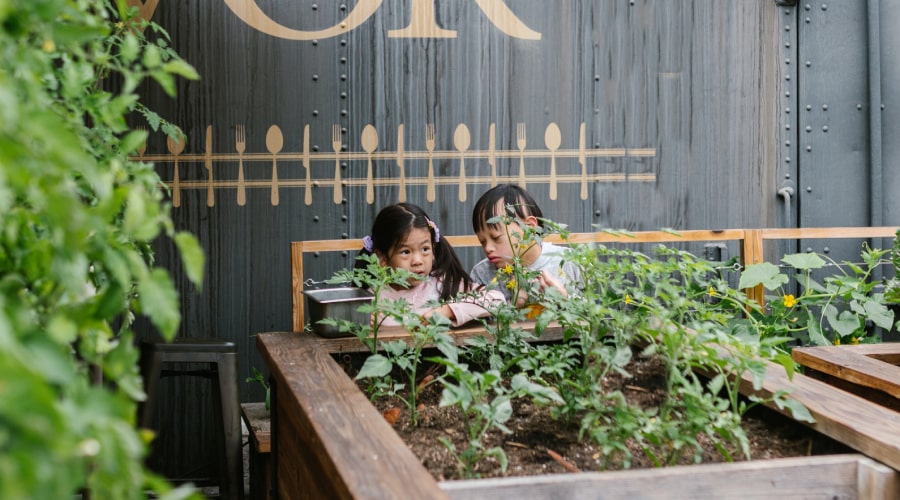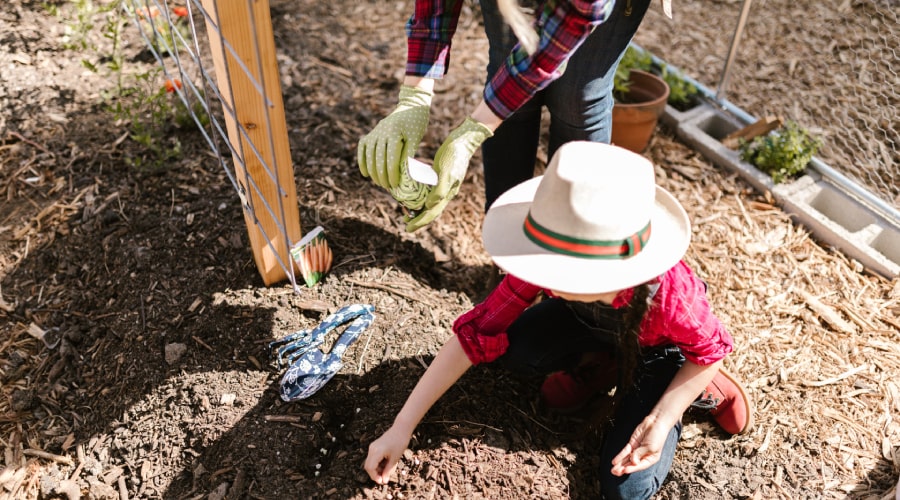settings
children
With Famly since
Children gain so many benefits from time spent outdoors, and especially time spent interacting with nature. As well as being great for health and wellbeing, time spent outdoors actually supports the development of self-regulation.
With an increasing focus on the importance of caring for our environment, and with the effects of climate change becoming ever more apparent, encouraging the next generation to ‘grow their own’ is a fantastic way to connect children with the natural world.
On top of that, the impact of the last few years of pandemic lockdowns has meant some children are experiencing delays in their physical development. Gardening offers great opportunities for fine and gross motor activities, with children naturally being more physically active when they’re outside. The time spent outdoors will boost children’s Vitamin D levels, too.
With that in mind, let’s take a look at how gardening can be weaved in and out of your curriculum, and exactly what plants are best to grow with little hands.

Growing a Curriculum
If you’re thinking that gardening doesn’t fit in with your curriculum, you’ll be pleasantly surprised that children can engage in gardening and flourish in their learning.
- Understanding the World: Time spent outdoors is great for introducing children to all kinds of knowledge about the natural world, such as the names of plants and wildlife, and it boosts scientific understanding through understanding what plants require to grow.
- PSED: Learning how to care for living things supports ‘Personal, Social and Emotional Development’, as it encourages children to set themselves simple goals and to think about healthy eating. It also helps them to build patience, as they watch and wait for their plants to grow.
- Physical Development: There are clear links between gardening and ‘Physical Development’, with children learning how to handle tools, building fine motor control when sowing seeds, and developing core strength and fitness by digging.
- Maths: A lovely activity for early maths is to try growing (and measuring!) some ‘Russian Giant’ sunflowers. Start your seeds off in late spring in small pots, one per child. Get the children to label their plants, cover them with clingfilm, then pop them in a warm place to germinate, such as a sunny windowsill.
- Measuring: As the sunflowers grow, and their roots fill the pots, the children will need to pot them on into gradually bigger containers. This offers a great opportunity to talk with the children about size and capacity. Get the children to measure their sunflowers over time to see who can grow the tallest!
Growing Spaces
You can get growing with children by using containers, even if you don’t have access to a garden area. In fact, growing in containers is often a better and more practical option for early years gardening.
Growing in pots means children can take their plants home with them to grow on or to plant out with parents. It’s easier to keep pests out when growing in pots, and you don’t need to worry about cats and other animals soiling your growing space. Children also love decorating and watering their own pots, so you can also turn it into a creative activity.
Many fruits and vegetables grow well in containers: from potatoes to carrots, and strawberries to blueberries. The great thing about growing in pots is that you can control the growing medium to suit different plants. In addition, because pots are raised up, they are more easily accessible for small children.

Growing Wild
It’s tempting to want your outdoor area to look pristine and weed free, but leaving part of your space as a slightly overgrown patch is actually important for attracting wildlife. Some of the most important habitat and food plants for insects are those that we would normally call ‘weeds’.
In order to make your garden attractive to wildlife, and also extra useful for learning, try and create bug friendly spaces where spiders, woodlice and snails can hide. You could build a ‘bug hotel’ with your children to support their learning about habitats.
But what plants are good for attracting insects and bugs?
- Nettles - Nettles are a vital food and habitat plant for many butterfly species, and a number of native butterflies lay their eggs on nettle leaves, including red admiral, peacock, comma and small tortoiseshell.
- Dandelions - Although gardeners typically hate them, dandelions are actually an important food source for pollinators such as bumble bees, hoverflies and so on, because they are in flower when very little else is. There is also the added benefit of dandelion ‘clocks’ for you to blow with your children!
Top tip: Remember when growing to be careful with any plants that are poisonous, and tell your children never to eat any part of a plant without checking with you that it is edible first. For instance, both tomatoes and potatoes have poisonous leaves. Although you’re probably unlikely to eat them, both nettles and dandelions are actually edible.
The big ideas

Easy Grow Options
Ideal plants to grow with children are those that are relatively quick, easy to grow, or that offer a special feature. When growing crops, aim for ones that can be eaten straight from the ground or the plant, ones that are versatile enough to be used in different ways, or ones that you know your children love to eat.
Here are a few easy grow options to start you off with:
- Baby carrots: Baby carrots are perfect for eating raw, and can easily be grown in containers. In fact, they are less prone to slug attack and to growing ‘wonky’ if you have them in pots. Scatter a light sprinkling of seed on the surface of moist compost, cover lightly with compost, and put some plastic over to retain moisture. As soon as the seeds have germinated, remove the plastic and grow on.
- Pumpkins: The great thing about growing pumpkins is how versatile they are. Not only are they superb for both savoury and sweet recipes, but they store for months and can be used for carving activities at Halloween. The seeds are also large, making them ideal for tiny hands. The only slight downside of pumpkins is that they need a lot of space to spread their leaves, so they are best for those who have a large plot.
- Potatoes: Potatoes are very easy to grow, both in the ground and in containers. Although it takes a while for your crop to develop, children absolutely love ‘earthing up’ (adding soil over the leaves as they grow) and digging through the soil in search of the potatoes when they are ready. The first time a child discovers potatoes hidden in the soil is a moment of wonder for all.
- Berries: Raspberries and strawberries are incredibly easy to grow, and children absolutely love to pick and eat them straight from the plants. While raspberries appreciate a deep root run (choose Autumn fruiting canes for the best results), strawberries will happily grow in containers, hanging baskets or raised beds, as well as in the ground.
Just remember to consider the size of the fully grown plants and remember to leave enough space between them - it’s easy to forget how big they can get when you’re looking at tiny seeds.

Support for Early Years Gardening
The Royal Horticultural Society (RHS) runs an excellent School Gardening Awards Scheme. The award is open to Early Years settings of all shapes and sizes, as well as home educators. The scheme helps you build your knowledge and skill, with vouchers and free resources on offer as you progress through the levels.
The Royal Society for the Protection of Birds (RSPB) has an excellent education offer, with an active Twitter account at @RSPB_Learning, and a ‘Wild Challenge’ award for schools and settings. There is also an annual ‘Big Schools Birdwatch’ event each January, with free resources to help you spot and identify the birds that visit your setting.
If you’re looking to develop or revamp your outside area, get in touch with local businesses to source free or discounted supplies. When we built our preschool garden, we received free materials from local building suppliers and £100 in vouchers from the local garden centre. A trip to spend our vouchers made an excellent educational day out for the children. The local press also ended up featuring our garden makeover, with ‘before’ and ‘after’ pictures in an article about our build!
Sue Cowley is an author, trainer and presenter who has helped to run her local early years setting for over a decade. Find out more at www.suecowley.co.uk.
Get 1000s of free EY activities
Want over 7,000 activities? See them in a free 14-day trial. Filter to target learning areas, age groups and topics, and get inspired.
Get started









